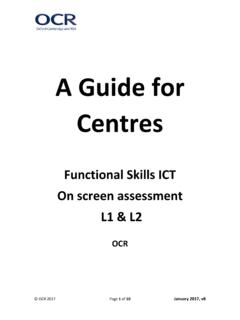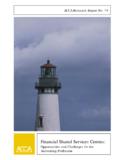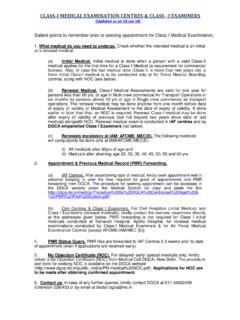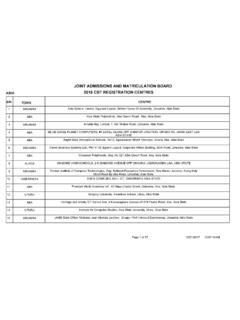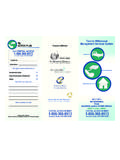Transcription of Design Guidelines Centres - WHO
1 DesignGuidelinesfor BloodCentresWHO Library Cataloguing in Publication DataDesign Guidelines for Blood Centres1. Blood transfusion. 2. Facility Design and construction 978 92 9061 319 0 (NLM classification: WB356) World Health Organization 2010 All rights reserved. Publications of the World Health Organization can be obtained from WHO Press, World Health Organization, 20 Avenue Appia, 1211 Geneva 27, Switzerland(tel.: +41 22 791 3264; fax: +41 22 791 4857; e-mail: Requests for permission to reproduce or translate WHO publications whether for sale or for noncommercial distribution should be addressed to WHO Press, at the above address (fax: +41 22 791 4806; e-mail: For WHO Western PacificRegional Publications, request for permission to reproduce should be addressed to the Publications Office, World Health Organization, Regional Office for the Western Pacific, Box 2932, 1000, Manila, Philippines, Fax.))
2 No. (632) 521-1036, email: designations employed and the presentation of the material in this publication do not imply the expression of any opinion whatsoever on the part of the World Health Organization concerning the legal status of any country, territory, city or area or of its authorities, or concerning the delimitation of its frontiers or boundaries. Dotted lines on maps represent approximate border lines for which there may not yet be full mention of specific companies or of certain manufacturers products does not imply that they are endorsed or recommended by the World Health Organization in preference to others of a similar nature that are not mentioned. Errors and omissions excepted, the names of proprietary products are distinguished by initial capital reasonable precautions have been taken by the World Health Organization to verify the information contained in this publication.
3 However, the published material is being distributed without warranty of any kind, either expressed or implied. The responsibility for the interpretation and use of the material lies with the reader. In no event shall the World Health Organization be liable for damages arising from its Introduction ..1 Notes on the contents of the Design guidelines2. Functional Brief ..7 Role and objective of the Blood Centre ..7 Planning Issues Growth and Change ..7 Risk Management ..7 Blood Flow ..9 Access and Location ..9 Hours of Operation ..9 Disabled Access ..9 Registration and Documentation ..9 Biosafety ..11 Irradiation Facilities ..11 Blood Disposal ..11 Staff Amenities ..11 Occupational Health and Safety.
4 12 Education and Training ..12 Security ..12 Stores ..12 Vehicle Parking ..13 Engineering Services ..13 Building Automation Systems (BAS) ..13 Waste Management and Disposal ..13 Dangerous Goods ..13 Departmental Objectives and Policies ..14 Blood Collection Facilities ..14 Mobile Blood Collection Units and Vehicles ..14 Demountable Collection Facilities ..14 Static Collection Facilities ..16 Processing ..23 Inventory and Distribution ..34 Laboratories ..42 Quality Management ..63 Administration and Management ..65 7 Engineering Department ..763. Design Brief ..83 Facilaity Planning and Design General Considerations.
5 83 Site Selection ..83 Good Manufacturing Practice (GMP) ..84 Building Elements ..84 Engineering Services ..88 Annex A ..96 Reference Documents ..96 Annex B ..97 Useful Websites ..97 Annex C ..98 Role of the Facility Manager ..98 Maintenance ..99 Annex D ..102 Glossary ..102 Annex E ..103 Abbreviations ..103 Annex F ..104 Acknowledgements ..104 IntroductIon 1 Maintaining a supply of safe blood and blood products has become a national priority in many countries. Achieving this aim requires the development and implementation of a national policy and the development of Guidelines to govern blood transfusion processes. There are a number of Guidelines that spell out how quality and safety can be Guidelines were prepared to assist countries in developing appropriate, purpose-built facilities for blood services.
6 They may be used to guide the Design of new buildings, to direct the renovation of existing facilities or even to improve work patterns by considering the layout in established facilities. Even if a new facility is not to be built, careful thought concerning the Design and layout of an existing facility is essential for safe and efficient function. These Guidelines are flexible. They can be adapted by countries with centralized services and by countries with multiple small facilities. Furthermore, buildings do not have to encompass every feature listed in these Guidelines in order to be safe blood supply depends on several important principles that have been set out by WHO in the Aide-M moire for National Blood Programmes: Blood Safety. The key elements are: establishment of a blood transfusion service; collection of blood from only voluntary, non-remunerated, low-risk blood donors; screening of all donated blood for transfusion-transmissible infectious agents; and reduction in unnecessary transfusions through the effective clinical use of of a quality management system covering all areas of the blood transfusion service is essential.
7 Key elements organizational management, standards, documentation, training and assessment are outlined in the WHO Aide-M moire for National Blood Programmes: Quality Systems for Blood Safety .Intent of the Design guidelinesThe Design Guidelines for Blood Centres was prepared by the WHO Regional Office for the Western Pacific. The need for such a document was identified at the Workshop on Nationally Coordinated Blood Transfusion Services, organized by WHO and held in Melbourne, Australia, 9 13 December Design Guidelines for Blood centresThis document will serve as a tool for authorities responsible for developing buildings to house blood transfusion services. It will assist national blood transfusion services (BTS) or ministries of health in determining the likely size and necessary content of blood transfusion facilities and how these facilities might operate.
8 It will also assist these authorities in developing an appropriate Design brief with their building Design Guidelines do not set out detailed and specific designs for blood Centres . Each facility should be designed as a specific response to unique local conditions. Rather, the Guidelines expound on the fundamental principles that should guide the development of detailed and specific designs when used by the BTS and their consultant Design team. They should be read and used in conjunction with relevant national and local standards and applicable Guidelines . Government and BTS policies regarding the provision of a safe blood supply must be taken into consideration. It is emphasized that facilities are part of the BTS, but facilities alone do not create a BTS or a safe and sufficient blood Services ModelsNo single blood services model is appropriate in all situations or locations.
9 Rather, there are a range of models that vary from centralized to decentralized. The determination of what is the appropriate blood service model for a particular country, state or province must take into account a number of considerations including the existing blood service infrastructure, transport infrastructure and the availability of skilled and trained blood services modelIn recent years, many developed countries have adopted a highly centralized blood services model with a national management structure and policies. A centralized blood centre (Processing, Testing, Inventory and Distribution) supports a large number of collection Centres distributed across the area serviced. Where logistics permit, centralization of processing and testing facilities has operational efficiencies, such as the use of complex and expensive equipment, staff training and quality management programmes to deliver consistently high-quality products for blood services modelOther countries have maintained a highly decentralized model with each collection centre supported by a Processing, Testing, Inventory and Distribution countries or regions have developed a hybrid of these two models, with some degree of harmonization of practice and centralization of post-collection activities.
10 These Guidelines have been written for both the newer centralized models and the more traditional decentralized 3Co-location of a small blood centre with a hospitalFor small or isolated communities, it may be appropriate to co-locate the blood centre with a hospital. This arrangement, if well managed, permits the sharing of buildings, skilled staff and equipment. The collection facilityAlthough the centre is co-located with a hospital, the donors are not patients. For social or cultural reasons, they may be reluctant to attend a donation centre in the hospital. It is therefore recommended that the collection facility should have its own address, signage and front door separate from other hospital entries. Processing and testingBlood donation, processing and testing can be carried out in separate facilities at the hospital or within the hospital pathology department, but only if activities are clearly separated and the security of donated blood can be ensured.










